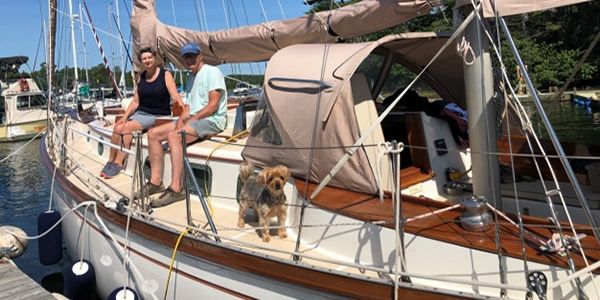From the Sponsor’s Desk – The Magic of EndFirst Project Planning
“You can’t connect the dots looking forward; you can only connect them looking backwards.” Steve Jobs
Have you ever had an Aha! moment? You know, that eureka realization when a seemingly brilliant idea occurs to you out of the blue. Unfortunately, all too often, those brilliant insights dissipate into the mists of time, never to yield that once promised bounty.
But occasionally the instigator, or in this case, one of the key collaborators, of one of those bright ideas will grasp the opportunity, pursue it through countless perils and pitfalls, overcome naysayers and persist to deliver something of value. That’s the case in this story. That beautiful vessel pictured above was masterfully, affordably and predictably refurbished because the owner, Alan Uren, had a vision – an app he called OVERGantt that would support EndFirst Project Planning.
Situation
Alan Uren spent over twenty years running his Priority Management franchise and guiding the growth of the company in Atlantic Canada and throughout New England. In 1999 he became the International Program Director, delivering training programs and project management services around the world. During that period, he and his colleagues were often called upon to help clients plan their own projects, both large and small. Alan’s team at Priority Management helped plan the delivery of almost $12 billion in successful projects, including shipbuilding, pipelines and a Statistics Canada census.
One of their earliest challenges was helping the organizing committee plan for the 1995 G7 conference in Halifax. It was a massive undertaking, involving more than 5,100 people, including about 2,100 members of the media, 2,000 delegates and about 1,000 security people. The federal budget for the Summit was $28 million and the provincial budget $5 million. With Priority Management’s help on the planning front, the conference was delivered successfully.
One of the techniques Alan and his team used that increased the effectiveness of the planning process significantly was called objective driven logic, what Alan now calls EndFirst Planning. Essentially, the technique starts with the desired end result and works backwards to deliver a time-scaled PERT network. Alan likens the approach to proofreading, where each sentence is read in reverse order.
The technique includes three distinct stages:
- Logic and schedule – this includes identifying and drawing out the tasks, their respective dependencies (links) and determining the initial schedule
- Resource levelling – by using key resource data from each task, resolving conflicts and optimizing the plan schedule
- Cost Calculation – this stage includes determining cashflow requirements, applying a calendar to the network diagram and identifying the critical path
Throughout the process of developing the network and building the plan, it’s the questions that matter. At the start and throughout the project, participants ask and answer one essential question: “What must be true at this moment in order to start this task?”
The other critical element in the use of the EndFirst Planning approach? Collaboration! The plan is built with the active participation of all the key stakeholders. In Alan’s experience, that active collaboration results in a remarkable level of confidence and understanding between the planners and contributors, leading to accurate, doable, yet compressed schedules, minimized rework, improved quality, enlightened cost control and heightened team collegiality.
The challenge Alan faced in those years was a lack of digital tools to support the EndFirst Planning approach. He tried most of the available project management programs over the years but found them all woefully inadequate for the EndFirst and collaborative mindset and methods. He often dreamed of building his own solution but lacked the time and skills to make it happen.
And then, in 2007, Alan decided to take early retirement. He acquired a 38’ Shannon ketch named Moonlight Maid and, together with his wife, enjoyed a life of adventure on the high seas. But he never gave up on his dream to create powerful, easy to use tools that would transform the EndFirst Planning and collaboration experience.

Finally, in 2017, Alan decided the time was ripe. He was ready to pursue his dream. He called it OVERGantt.
[widget id=”custom_html-68″]
The Goal
To create a tool set specifically for EndFirst Planning and participative collaboration that would be accessible and affordable and easy to learn and use.
The Project
Alan started his innovator journey with considerable research. He revisited the project planning and management tools on the market and assessed them for EndFirst Planning and participative collaboration fit. He found all wanting.
He then dabbled in his own creations using spreadsheet tools and drawing applications. These too were not up to the task. Frustrated, he went back to his colleagues, to other project management practitioners, to experts in the field. They told him that what he wanted to do hadn’t been done before and most were skeptical that it could be done.
And then one day, trying out some ideas using Numbers, the Apple spreadsheet, on a Mac, he had a breakthrough. He found he could tie the power of graphics and the spreadsheet together to realize his vision. A robust solution needed some code. He enrolled with Volta Labs, a local incubator, to take courses to improve his coding expertise and application development knowledge. As the program evolved, he contracted a developer through freelancer.com and together they went to work.
Over the next eighteen months, they built the app’s capability. It could support network drawing, a modern alternative to bar charts. It could record the key attributes about each task including deliverable or sub-project, description, ID#, predecessors, successors, duration, resource name, costs, planned and actual start date, planned and actual finish date and special conditions. It could calculate the critical path and display it on the network diagram. It could apply the network to the calendar. It could manage specific and generic resource types and their associated cost and availability. And it could calculate total costs and costs by calendar period.
OVERGantt was a beautifully different beast. It created a plan by first drawing a network diagram and then extracting that data to a spreadsheet to provide the computational power. It placed the emphasis on the network diagram to visually support the EndFirst Project Planning exercise. Alan and his app developer were ready for a pilot project.
About that time Alan was considering having some repairs done to Moonlight Maid. After 20,000 nautical miles of sailing, the boat was showing signs of wear and tear. He was in discussions with a regional shipbuilder about 45 km from his home. It occurred to him that the project would be a perfect test for the OVERGantt app. He discussed the possibility of using the app to plan and track the project with the shipbuilder and he was game. And so the pilot began.
Alan sailed Moonlight Maid to the shipyard and spent a day with the shipbuilder drafting the plan using the OVERGantt app. The shipbuilder was initially intimidated. Using technology to plan ship repairs was something he hadn’t done before. However, as the day went on, he and Alan went over the boat and entered their findings in OVERGantt on Alan’s MacBook. The shipbuilder became much more comfortable with the process and, by the end of the day, he was a fan. They had identified the key tasks, the expected resources required, the various dependencies and determined the critical path. Over the next few weeks, they fleshed out the plan, applied it to the calendar and calculated the costs. The plan at that point included 30 tasks.

Alan met with the shipbuilder weekly, occasionally on site but mostly on a remote basis. The shipbuilder was able to view the OVERGantt app remotely through his iCloud account, so they were still able to collaborate on the plan, progress to date, work planned for the immediate future and revisions to the plan. As work progressed, Alan realized he was missing an opportunity. The repairs were extensive and a full refit probably wouldn’t cost significantly more or take significantly longer. So he and the shipbuilder reviewed and revised the plan to include all of the full refit tasks. As they had a much better understanding of the condition of the boat because of the work done to date, the revisions we done quickly and added minimally to the overall schedule. And so the work progressed.

The Results
The refit of the Moonlight Maid started in January 2019 and was completed in August as planned. The plan was substantially revised twice; once to reflect the scarcity of resources because of the demand for the shipbuilder’s services in the spring, and once to accommodate the shift in scope from repair to refit. Alan was thrilled. The shipbuilder was too. OVERGantt was a force multiplier, enabling better collaboration and communication, leading to faster completion, great quality, enhanced value and effectively managed costs.
Alan used the experience from the refit of his boat to add a few features and improve the ease of use and stability of the OVERGantt app. In September, he won an innovation award from Innovacorp for his OVERGantt idea. It spurred him on.
He launched OVERGantt officially on Feb 5, 2020. You can check it out at EndFirst Plans.
How an Intrepid Explorer Delivered
The path to innovation usually starts with a question. That’s what Autodesk’s Innovation Genome Project determined after it tried to quantify what worked on the 1,000 greatest innovations of all time. With that data in hand, they quickly identified seven questions that famous innovators have consistently asked and answered to generate ideas that can lead to new innovations.
Here are the 7 questions the Innovation Genome Project came up with:
- What could we look at in a new way, or from a new perspective?
- What could we use in a new way, or for the first time?
- What could we move, changing its position in time or space?
- What could we interconnect in a different way, or for the first time?
- What could we alter or change, in terms of design and performance?
- What could we make, creating something that is truly new?
- What could we imagine to create a great experience for something?
Look familiar. It should. Take a look at the journey Alan traveled to reach the February 2020 launch of the OVERGantt app. I think he touched each of those questions at least once, some multiple times.
Thomas Edison is quoted as saying “The three great essentials to achieve anything worthwhile are, first, hard work; second, stick-to-itiveness; third, common sense.” I think Alan has proven Thomas Edison correct!
So, when those Aha! moments occur to you, pause a moment to consider the real possibilities. And when you decide to pursue one of those ideas, ponder the above questions and leverage EndFirst Planning to deliver successfully. Also remember, use Project Pre-Check’s three building blocks covering the key stakeholder group, the decision management process and the Decision Framework right up front so you don’t overlook these key success factors.
Finally, thanks to everyone who has willingly shared their experiences for presentation in this blog. Everyone benefits. First time contributors get a copy of one of my books. Readers get insights they can apply to their own unique circumstances. So, if you have a project experience, a favorite best practice, or an interesting insight that can make a PM or change manager’s life easier, send me the details and we’ll chat. I’ll write it up and, when you’re happy with the results, Project Times will post it so others can learn from your insights.





